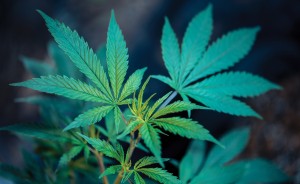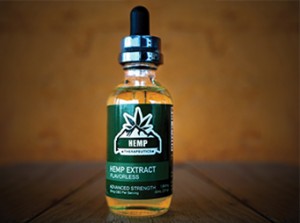Cannabis and Canines – How CBD Oil Benefits Dogs
Click here to read the complete article
214 – September 2019
A year ago we had a vendor selling hemp products at our show. It was met with some horror by our older members. Last week we went to another show. They had two hemp vendors, and they seemed to be doing a bang-up business. In fact, their customers included one of our older members!
That seems to be the case throughout the country. People who never would have smoked a joint are now buying cannabis products for themselves—and for their dogs. Several years ago I wrote a book about cannabis for dogs (Cannabis and CBD Science for Dogs) and, in the forward, I expressed my initial skepticism for something that claimed to treat everything from acne to schizophrenia. By the time I wrote the book, I was familiar enough with the science that I understood the basis for these claims. Now, I’ve reviewed enough research studies and talked to enough people to be convinced that cannabis represents a revolution in medicine that anyone would be foolish to ignore. The problem is that there’s so much disparate information that it’s hard to know what to believe, much less whether it’s worth (or even safe) to try on your dog. So, here’s a cannabidiol (CBD) primer.
What is CBD? CBD stands for cannabidiol. It’s one of many compounds collectively known as cannabinoids that are found in hemp plants. The most well-known cannabinoid is THC (tetrahydrocannbinol). But, there are big differences between the two compounds, the most obvious being that THC gets you high and CBD doesn’t.
Plant breeders have been very successful in creating cannabis plants with very high levels of THC. We call these plants marijuana. Plants particularly low in THC (under 0.3%) are called hemp. These are the plants CBD is derived from.
How Does CBD Work? Neural cells send messages to one another by means of chemicals called neurotransmitters, which are released from the end of one neural cell, travel across a tiny gap, and fit into a receptor on the next cell like a lock and key. That cell, in turn, sends back a different neurotransmitter—an endocannabinoid—to turn off the first cell’s transmission by fitting into a cannabinoid receptor on the first cell. The cannabinoids made by plants are virtually interchangeable with the endocannabinoids the body produces.
Cannabinoids, thus, modulate every other neurotransmitter in the body. They act like a master regulator, telling some neurons to increase firing and others to slow it down, telling some systems to fight problems and others to restore the body to its resting state. For example, the endocannabinoid system signals the immune system to fight an infection as well as to stop fighting it when the threat is gone. Cannabinoids are responsible for the body’s homeostasis, regulating, for example, temperature, mood, appetite, and the immune system.
CBD is not THC’s poor relation but is instead distinct in its actions. A 2017 World Health Organization review state, “Across a range of measures in humans and animals, CBD had been shown to have very different effects from those of THC… Neuroimaging studies in humans and animals have shown that CBD has effects which are generally opposite to those of THC. In contrast to THC, CBD has no effect on heart rate or blood pressure under normal conditions, but in animal models of stress it reduces heart rate and blood pressure.”
Is CBD Safe? A 2017 review concluded “In general, the often described favorable safety profile of CBD in humans was confirmed and extended by the reviewed research. The majority of studies were performed for treatment of epilepsy and psychotic disorders. Here, the most commonly reported side effects were tiredness, diarrhea, and changes of appetite/weight. In comparison with other drugs used for the treatment of these medical conditions, CBD has a better side effect profile.”
Note, however, two precautions. 1) CBD has been associated with higher liver enzymes in some users. This is more likely with higher intake of CBD and is reversible. However, it may be a good idea to have liver enzymes checked periodically when taking high levels of CBD. 2) CBD inhibits the ability of the liver enzyme cytochrome P450 to metabolize many of the drugs (about 60% of marketed medicines) we and our dogs consume. This means that drugs may stay in the system longer, or that the metabolized version of a drug may be delayed, which could be bad if that is the version that is therapeutic. This could be important with drugs with small safety or efficacy margins, such as some blood-thinning, chemotherapy, and epilepsy drugs. Don’t give your dog CBD with other drugs without telling your veterinarian.
Why Doesn’t My Veterinarian Prescribe It? The Federal Controlled Substances Act outlaws the possession of Cannabis Sativa with a THC concentration of more than 0.3%, but the Agricultural Act states that industrial hemp, with less than 0.3% THC, may be grown under some conditions if state law allows. However, the American Veterinary Medical Association’s (AVMA’s) Council on Biologic and Therapeutic Agents issued a statement in January 2018 maintaining that CBD is the same as marijuana, and that neither has been approved for use in companion animals, and, thus, any veterinarian prescribing either could lose their license. This is currently being disputed, with an answer due by January 2020.
Where’s the Dog Research? The same AVMA opinion has led to several universities cancelling their CBD research projects for fear of repercussion. Planned research at Auburn, Cornell, and the University of Pennsylvania was halted. Publishing the results in U.S. journals has also proved problematic. Most researchers are focusing on basic research they can conduct without directly handling cannabis products. For example, some offer free blood monitoring of pets whose owners are administering CBD, and they are looking at whether the number of cannabinoid receptors differ in normal versus abnormal animals.
Auburn University researcher Dawn Boothe, DVM, MS, PhD, postponed her study of CBD and epilepsy. Instead, Auburn is asking owners who are giving their pets cannabis products to answer a survey about the good and bad effects. They also allow owners to submit a sample to be tested. At UC Davis Veterinary School, Jamie Peyton, DVM, also has an ongoing survey for owners who are giving their pets cannabis products.
In 2016 Colorado State University surveyed 457 owners of dogs who bought CBD oil from one supplier. Overall, 93% of respondents preferred CBD over either some, most or any other medication (https://www.ahvma.org/wp-content/uploads/AHVMA-2016-V42-Hemp-Article.pdf).
Among those owners with an opinion:
• 95% report the CBD product provided pain relief either moderately or a lot.
• 92.8% report the CBD product provided nervous system support either moderately or a lot.
• 92.0% report the CBD product helped relieve seizures or convulsions either moderately or a lot.
• 91.9% report the CBD product reduced inflammation either moderately or a lot.
• 88.8% report the CBD product aided sleep either moderately or a lot.
• 83.2% report the CBD product helped relieve anxiety either moderately or a lot.
• 82.3% report the CBD product helped reduce nausea or vomiting either moderately or a lot.
• 78.6% report the CBD product helped reduce muscle spasms either moderately or a lot..
• 73.0% report the CBD product inhibited growth of cancer or tumor cells either moderately or a lot.
• 70.8% report the CBD product helped digestive tract problems either moderately or a lot.
• 64.8% report the CBD product helped thunderstorm or fireworks phobia either moderately or a lot.
• 61.8% report the CBD product helped skin conditions either moderately or a lot.
Here’s what we know from the few canine objective studies. Stephanie McGrath, DVM, examined the pharmacokinetics of CBD oil in 30 research beagles, measuring blood parameters in dogs given various combinations of doses and delivery methods (of capsules, tincture, and transdermal cream, tincture was most promising). Oral administration was most effective, and no harmful side effects were found, even after doses of 175 mg every 12 hours for 6 weeks (Canadian Journal of Veterinary Research, Volume 82, Number 3, July 2018, pp. 178-183(6)).
In a Cornell study, Joseph Wakshlag, DVM, PHD, conducted a double-blind study, in which 16 dogs were given a CBD product or placebo twice a day for four weeks, then, after a two-week break, the opposite product for the next four weeks. Wakshlag reports that, overall, the dogs exhibited remarkable improvement. The Canine Brief Pain Inventory score and Hudson activity score (a scale questionnaire used to assess pain and lameness in dogs) was used to determine response to treatment. Over 80% of the dogs showed significant improvement in pain relief and quality of life. Wakshlag says that some dogs were initially so decrepit that their owners considered euthanasia, but after just days on CBD were trotting around and even climbing stairs. Pharmacokinetics demonstrated that CBD half-life is 4.2 hours, suggesting that twice daily dosing is optimal. (Front. Vet. Sci., 23 July 2018).
Humans and Other Guinea Pigs: Most of the research information we have comes from studies using either rodents or humans. Because all vertebrates have an endocannabinoid system, researchers tend to extrapolate finding from one species to another, although, of course, this is not perfect. There is strong support that CBD helps with the following conditions: acne, addiction, Alzheimer’s, anxiety, arthritis, autoimmune disorders, bone fractures, colitis, depression, diabetes, inflammation, migraine, mood disorders, multiple sclerosis, nausea, seizures, and stress. There is support, but not as strong, that CBD helps with ALS (the human analog to degenerative myelopathy), cancer, fibromyalgia, heart disease, pain, and PTSD. There is promising or mixed support for a number of other disorders.
Choosing a Product: Use an oil or other product that is absorbed in the mouth, not swallowed. Buy from an American (North or South) or European source—never China. China produces about a quarter of all hemp grown in the world, but much of it is grown in soil contaminated with heavy metals and toxins, which hemp readily absorbs.
Buy a full-spectrum product that uses the entire plant. Several studies have shown that CBD in a plant extract is more effective than pure CBD. Other cannabinoids, as well as terpenes and flavinoids in the plant, work together synergistically to produce the entourage effect, in which whole-plant derivatives work better than isolated components.
Buy a product that can produce evidence of quality control from a third-party lab. In a 2017 study, 84 products from 31 companies were analyzed for label accuracy. Of these, 43% actually contained higher levels of CBD than the label claimed, 26% contained lower levels, and 31% contained the claimed level. Oils tended to be labeled accurately the most, with vaporization liquid mislabeled the most. THC was detected in 21% of the samples. Companies should have data on testing of their products.
Buy a product that uses supercritical CO2 extraction rather than solvents to extract CBD. Solvents may include toxic chemicals.
How much to use? CBD is well-tolerated in humans, with doses up to 1500 mg a day not resulting in psychotic symptoms. But, CBD is expensive, so you don’t want to use more than you need. With many conditions, such as anxiety, there’s some evidence that there’s a sort of sweet spot of dose level that works far better than if you took more or less of it. In the Cornell canine arthritis study, doses of 2 mg/kg were effective. For others, most notably epilepsy, it seems the more the better—it’s not uncommon for these patients to take CBD pills with hundreds of milligrams of CBD in them. So, in most cases you have to experiment, working upwards until you see the effect you want. No two people, dogs, or products are the same.
The form in which you take CBD affects how much is absorbed. The worst absorption comes from swallowed forms because the digestive tract does not allow much CBD to pass into the bloodstream. Vaping, in which the CBD goes directly to the capillaries of your lungs, gives the best rate of absorption, but it’s not realistic for dogs! CBD drops applied under the tongue have an intermediate rate of absorption. These drops are absorbed directly through the tissue and into underlying blood vessels. Let CBD oil sit under the tongue or on the gums for 30 seconds.
A final caution: If you’re thinking of using CBD to help your dog de-stress and perform in the ring, think again. While it may work, and it may prove to be a good training aid, according to the AKC Rules Applying to Dog Shows (page 45), the use of any drugs or substances that improves a dog’s natural temperament shall disqualify that dog from competition.
Click here to read the complete article
214 – September 2019
Short URL: https://caninechronicle.com/?p=170046
Comments are closed












